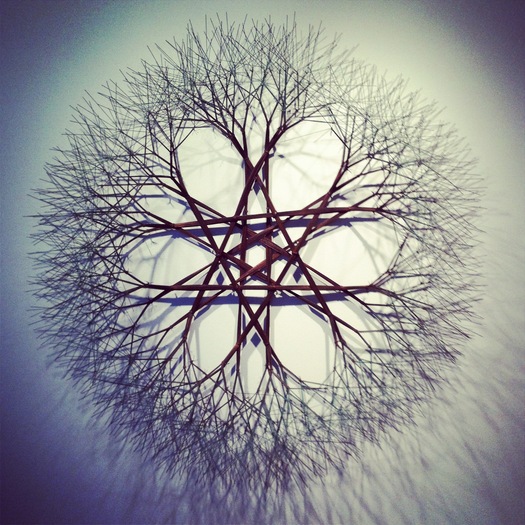
Ruth Asawa for LIFE, 1954 (Photo by Nat Farbman, via Christie's)
When I wrote about the figure of the knitting architect in February, inspired by Maria Semple's novel Where'd You Go, Bernadette, little did I know that a panoply of knitted, woven and recycled work would soon be on display in New York ... all under the rubric of art, but definitely spatial and challenging. El Anatsui's sinuous works at the Brooklyn Museum, which play with one's sense of weight and material, Orly Genger's Red, Yellow and Blue in Madison Square park, walls of crocheted rope that snake through the park, and, most modest in scale, the first New York show in 50 years of the work of midcentury sculptor Ruth Asawa, who wove forests, anemones and orbs out of metal wire. One of Asawa's largest works, known as Untitled (S.108, hanging, six lobed, multi-layered continuous form within a form), was auctioned by Christie's, the organizers of the exhibition "Ruth Asawa: Objects & Apparitions", on May 15 for $1.4 million, four times its low estimate. (I posted a few of my own photos of the exhibit on Tumblr; Christie's also made a video.)

Ruth Asawa, Untitled (S. 144, Wall-Mounted, Tied Wire, Open Centered, Six-Pointed Star with Six Branches), 1998 (my photo)
I first encountered Asawa's work in the corners of photographs of the Design Research stores in Cambridge and San Francisco. Her wire sculptures, which she began making in the late 1940s, were shown and sold in both places. Inspired by traditional Mexican wire baskets, made by a Japanese-American modernist, these pieces embodied the roots of the D/R aesthetic. In person, they also recall the work of Isamu Noguchi, particularly his Akari light sculptures. Both the Akari and Asawa's lobed pieces are extremely delicate — hers are transparent — and yet can take up quite a lot of room. Their strangeness makes you want to back off, their intricacy makes you want to zoom in. And their shadows are a separate spatial construct.

Ruth Asawa, BMC Stamp (BMC.76), c. 1946-1949
Asawa trained at Balck Mountain College, and the additional revelation of this exhibit were her drawings and works on paper. I had thought of the sculpture as form, but the drawings also made me consider them as line, just as Genger's rope works are both gargantuan lines and made of thousands of lines. Several drawings, one in pink-on-pink, showed a repeated wave, eddying in different directions, playing with positive and negative space. Another set used rubber stamped letters (sans serif, all caps) to make patterns, one playing against the different lettered grain of a piece of newsprint.
Asawa continued to make her sea creature-like pieces through the 1990s, but another set of works use bunched wire to make rather deadly-looking wreaths and trees. These reminded me of her contemporary Harry Bertoia and his spiky dandelions. (Until May 24, DORMA is exhibiting some of Bertoia's sound sculpture, mushrooms and other metal pets.) The combination of anemones and trees made me think of Asawa as a weaver of witchy tales, geometric, lightweight, and yet fearsome.

Ruth Asawa, Sculptor, and Her Children, 1958 (Photo by Imogen Cunningham)
Christie's biography smooths over any rough edges, but there were a couple of statements that caused me to wonder. Asawa, like Noguchi, was held in a Japanese-American internment camp in the 1940s. The press release quotes her as saying, "I hold no hostilities for what happened; I blame no one. Sometimes good comes through adversity. I would not be who I am today had it not been for the Internment, and I like who I am." It also describes her weaving her nets in the company of her six children, adorably photographed by Imogen Cunningham: "Asawa's looped wire forms were often executed in her home, with her six children surrounding her, creating a poetic narrative in which life intertwines with art." Whose choice was it to intertwine the two? And what, beyond poetics, was the effect on her work? I am looking forward to reading the catalog from Asawa's 2006 exhibition at the De Young Museum in San Francisco. I hope this exhibit, the accompanying book, and that million-dollar sale, will provoke more writing about Asawa and her multivalent connections to the postwar and contemporary art, architecture and design worlds.
